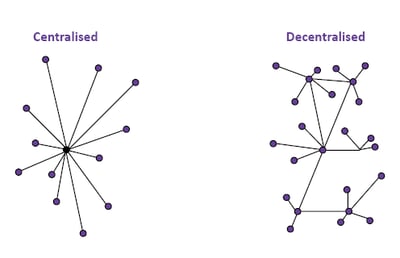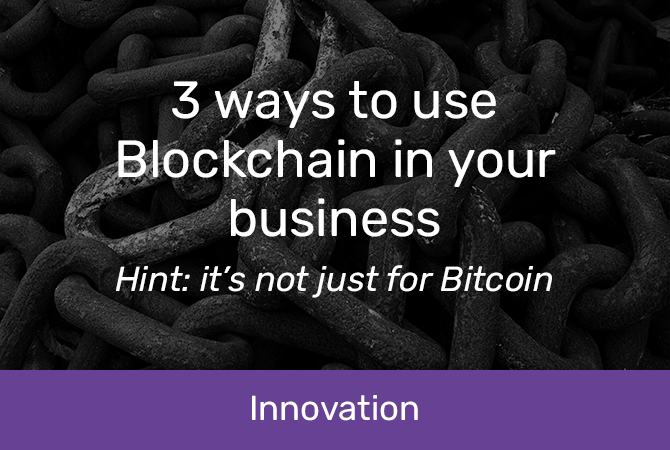
3 ways to use Blockchain in your business
(hint: it's not just for Bitcoin)
2018 was a year of changing tides, particularly with regards to data transparency - we had the GDPR come into effect, we witnessed the Cambridge Analytica scandal and we watched Bitcoin soar to nearly its highest price, then sink and soar again. With the growing awareness of Bitcoin (and the 700+ other cryptocurrencies like it) has come an unsurprising amount of discussion around the technology that makes it so unique: Blockchain.
Most people with tech-awareness have strong opinions about Blockchain - they either love it, they hate it or they don’t really know what it is, beyond the fact that it’s somehow related to Bitcoin. So to begin, it’s important to note that Blockchain ≠ Bitcoin. Blockchain is a software that keeps unalterable records using cryptography, and Bitcoin is a cryptocurrency that uses Blockchain in order to be transparent and secure.
‘I need more than that. What exactly is Blockchain?’
I suppose first we should clarify that for our purposes, ‘Blockchain’ really refers to a blockchain, which is a continuously growing list of records (known as blocks) that are linked and secured to one another cryptographically (through codes). Each block points at the previous block in the chain and includes a unique value representing the content of that record, as well as its location. This chain of data is different than a non-Blockchain linked list, which would have blocks that indicate to the previous block in the chain, but don’t actually show its value. 
Once a transaction is entered in a blockchain, it can’t be altered - this is because the block is linked to every block before and after it, so changing the value of the block would disrupt the entire web of blockchains in the system and would therefore be overwritten. Another basic principle is peer-to-peer transmission, meaning communication occurs between peers rather than through a central node. This allows for ‘democratised’ data, as each party can access the entire database and see all transactions.
I could go on and on about the intricacies of the technology, but I’ll summarise with this - blockchains are irreversible community-managed linked lists of transactional data designed to be extremely transparent and secure.
Blockchain has potential far beyond the cryptocurrency it’s historically been associated with - there are a number of different ways that Blockchain technology can be implemented in businesses. Let’s look at three of them:
Another common reason some businesses use Blockchain to record their data is for consistency. Because multiple users rely on the information within an organisation’s dataset, it is essential that they’re able to ensure no modifications have been made which would affect the end results. As you can imagine, it’s incredibly hard to identify these changes amongst millions of rows of data.
In these cases, some businesses use Blockchain to summarise and ‘hash’ the information in the dataset in order to keep a record of it. Another solution is to store the dataset itself as a blockchain - blocks of transactions/customers/stores would be input and become unalterable, meaning the users wouldn’t have to check to make sure the data hasn’t been changed.
There are two issues with using Blockchain for data consistency:
- Hashing individual rows, as described above, could potentially be really expensive (that’s a lot of storage). One option to mitigate this cost is to store a reduced version of the hashes - for example, only store the hashed summary of your sales/transactions etc. per day rather than the numerical value of each individual transaction.
- There might be a legitimate reason for changes to occur in the data - if that happened, you would have to rebuild the entire blockchain, as only changing the affected block would cause the blockchain to not reconcile.
Our analytics platform is designed to facilitate data sharing, or 'data-pooling' as it's also known, between businesses across all industries and geographic locations. We have various data storage technologies, some of which are Blockchain-based, which offer a couple of benefits for users. Firstly, the record logs are more secure than they would be otherwise - secondly, the peer-to-peer nature of a blockchain works very well in a data sharing context, as users across the platform are able to work collaboratively on their data with the knowledge that usage is securely tracked.
‘So what’s the catch?’
With all that good stuff said, there are a few drawbacks to Blockchain technology that are worth considering (beyond the ones mentioned with regards to data consistency):
- Blockchain is generally expensive, both computationally and in terms of storage - because a blockchain stores every bit of transactional information, it can grow very big very fast. And big data is expensive to store.
- It can be difficult to extract information from a blockchain, as the continuous addition of nodes makes the chain grow at a rapid rate
- This also can cause computation to be far slower, and thereby more expensive, than it would be on a traditional computer
- The irreversibility of Blockchain poses an issue, should there ever be a need to alter accounts. However, if every user of that particular system agrees to rewrite the chain from a certain point, it can be done – it just requires approval from everyone.
‘Why the sudden fascination with Blockchain?’
Datamine has done a number of projects using Blockchain technology, such as in the above examples, and we’re interested in the various implementations that can arise from it (for example, many organisations today are interested in using this style of record keeping within an enclosed system, even restricting access to the records based on role, seniority etc.). Blockchain is by no means a perfect technology, but we do think it’s important to recognise that it’s a valid data storage option in today’s tech-forward world.
To hear more about what we’ve doing with Blockchain, or to learn about how Datamine could help you implement it in your business, get in touch with us for a chat.
In the meantime, here is a video discussing some tangible Blockchain applications across multiple industries:
 ABOUT THE AUTHOR: PAUL O'CONNOR
ABOUT THE AUTHOR: PAUL O'CONNOR
Paul founded Datamine in 1995 and has overseen the company's growth into its current position as a key player in the data analytics community. He brings a human touch to data analysis, translating 'geek-speak' into English and never failing to turn the imponderable into actionable insights.














































